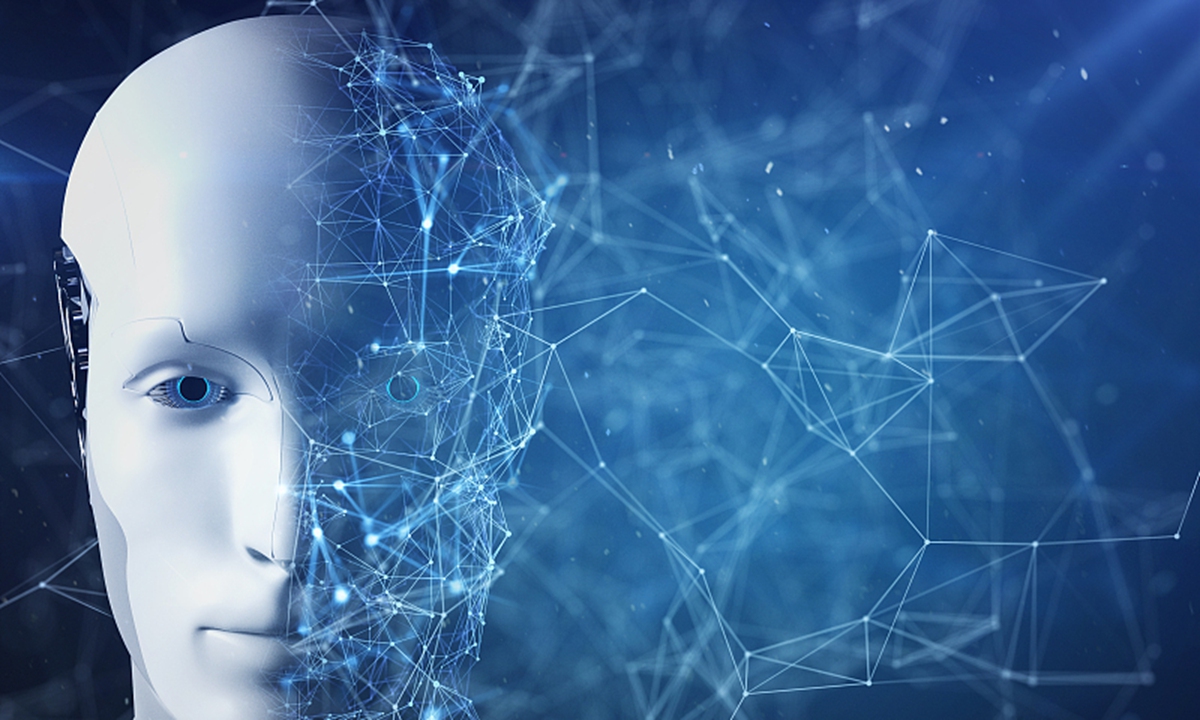
Artificial Intelligence Photo: VCG
Generative artificial intelligence (AI) can complete image creation and document writing in seconds, bringing novelty but also causing more anxiety for creators.
The first case of copyright infringement involving AI-generated images in China has recently been finalized, with the plaintiff Li Yunkai winning the lawsuit but waiving the 500 yuan ($70) compensation from the defendant.
Li Yunkai recently told the media that the compensation is not important to him; he rather hopes that the court can provide a clear criterion on whether using AI to generate images constitutes original work and possesses original work of authorship.
In this particular case, the Beijing Internet Court recognized the picture generated via text-to-image AI image generator should be considered original “artwork” under the protection of copyright laws based on the “originality” and intellectual input of its human creator.
However, industry observers noted that the case also emphasized whether the artificial intelligence-generated content (AIGC) constitutes a work with copyright cannot be generalized but should be decided on a case-to-case basis.
Why is that? Observers argued that, to protect AIGC, it is necessary to establish whether the subject of the right is a human being rather than the machine or the AI.
Li Zonghui, the vice president of the Institute of Cyber and Artificial Intelligence Rule of Law affiliated with Nanjing University of Aeronautics and Astronautics, told the Global Times that the current copyright law defines the subject of the work as the author, citizens, legal persons, and social organizations. It is evident that AI does not meet this requirement.
Back in 2018, the US Copyright Office received its first known copyright registration application for an AI-generated work. But later in 2023, the court rejected the application because AI, as a non-human, is not subject to copyright protections.
In this case, Stephen L. Thaler intended to claim authorship of a visual image titled “A Recent Entrance to Paradise,” which was generated by his developed AI system known as the "Creativity Machine."
“Protecting content generated by non-human beings as works with copyright is fundamentally contrary to the legislative purpose of copyright law,” Li Zonghui noted. In the Beijing case, the court rule was based on the fundamental principle of protecting the rights of “human being.”
According to the court, if an AI-generated image reflects the original intellectual investment of a human being, it should be considered artwork and protected under copyright law. However, determining the extent of the original intellectual investment made by a human being in the creation process poses a challenge.
The Beijing Internet Court believes that the plaintiff Li Yunkai designed the visual elements of the character and its presentation through prompts and set parameters for the layout and composition of the image. He continued to add prompts and modify parameters after obtaining the first image, constantly adjusting and revising, and finally obtained the image. The process reflects the plaintiff's aesthetic choices and personal judgment, the court believed.
Li Zonghui pointed out that if a work is purely generated by AI without any contribution from the user, it may not be subject to copyright infringement. The key factor lies in the prompts and what kind of modify parameters given to the machine and whether they constitute originality.
Some industry observers argue that writing prompts to generate a work is a simple task, resulting in a minimal intellectual contribution to AI-generated image creation.
AI systems have the capability to replicate on a large scale, enabling the generation of a vast number of images or content within a short period. If copyright protection is granted to all of this, it will not foster innovation for society as a whole, stated You Yunting, a Shanghai-based lawyer, in an interview with The Paper.
Machines’ deep learning is essentially a statistical process that involves collecting large-scale data and performing rapid calculations and deductions. Therefore, it is not the same concept as human original expression, Andy Sun Yuanzhao, executive director at The Asia Pacific Legal Institute, wrote on Copyright Theory and Practice recently.
Apart from lawsuits relating to AI-generated images, China has also seen a first legal dispute over a virtual human.
In July 2022, a technology company in Hangzhou uploaded a video to their Douyin account featuring Ada, a virtual human created by Shanghai-based Xmov Technology but failed to acknowledge Xmov as the original creators. The Hangzhou Internet Court later sided with Xmov, ordering the infringing company to pay 120,000 yuan in compensation.
Analysts said there is a connection between virtual humans and works in copyright law and the right of portrait and personality in civil law.
If the character’s appearance is completely newly designed, then the virtual digital human may constitute an artistic work and be protected by copyright law. If the character is based on the modeling of a specific natural person, then the virtual digital human involves the use of the likeness of a real person and requires the permission of the right of personality holder, Li Zonghui told the Global Times.
One judgment of copyright infringement will certainly lead to more subsequent lawsuits. The aftereffects will be the increase cost and market entry barriers for the subsequent development of the AI industry, Sun said.
Given that these lawsuits usually last for a long time, unless the parties can reach a pre-litigation settlement, the entire AI industry is likely to be in a state of uncertainty for a considerable period of time in the future, Sun said.




